- Article tells about Motifs in Pithora Painting,
various deities of Rathwa community and how they form part of the painting
tradition, motifs in nature-human-animals and how these paintings are made.
Pithora is
a ritualistic painting done on the walls by
the Rathwa and Bhilala tribes who live in
central Madhya Pradesh. Pithora paintings are executed on the three inner
walls of their houses. These paintings do have significance in their lives and
executing the Pithora paintings in their homes brings peace, prosperity and
happiness. Please make a note that there is never an attempt towards imitating
nature: a horse or a bull, which might be a vision of a god, impresses him with
only one central quality.
Note that Pithora paintings are more of a ritual than an
art form.
These rituals are performed either to thank God or for a wish or a boon to be
granted.
The
Bhadwa or the head priest of the
tribe is summoned and the problems are narrated. These problems can vary from
dying cattle, to unwell children in the family. The concerned person is given a
solution and is asked, by the Bhadwa, to perform the ritual and the painting.
The presence of Pithora Baba is often considered as a solution to all the
problems. A Pithora is always located at the threshold, or the Osari, outside
the first front wall or inside on the walls of the first room as one does enter
a house. The painting usually floods the entire wall with figures.
Three
walls are prepared for the painting, the front wall and the two on either side
of it. The front or central wall is very large, twice the size of each of the
sidewalls. These walls are treated with two layers
of cow dung paste and one layer of white chalk powder. It is interesting
that the unmarried girls bring in these materials.
This
procedure is called Lipna. The main
wall of the verandah that divides it from the kitchen is considered sacred to
the Pithoro. The wall paintings
related to the legends of creation and Pithoro, are done on this wall. The two
sidewalls of the veranda are also painted with figures of minor deities, ghosts
and ancestors.
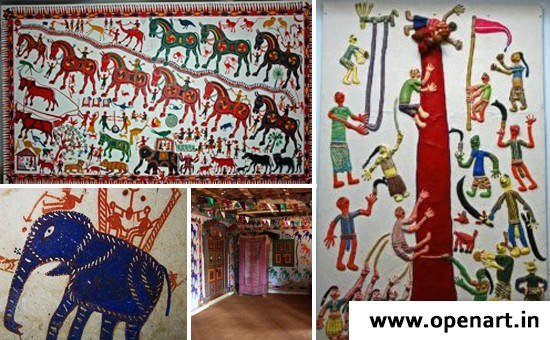
Reference
and Photo Credit
Motifs in Pithora Painting
The
motifs in the Pithora painting represent the tradition of the community along
with exclusive depiction of the most essential aspects of the daily
life. The protagonists of the entire painting are horses of the gods
and goddesses and ancestors in vibrant colours. The painting is adorned
with motifs from nature, daily human activities, animals, farming, trade, important
members of the community, along with several new elements, which symbolically
represent modernity.
The
chief deities that appear in the Pithora painting
are Baba Ganeh, Baba Ind, Baba Pithora, Pithori Rani, Rani Kajal, Baar Matha no
Dhani Raja Bhoj, Abho KunbiNakti Bhuten, Lakhari & Jokhari and Purvaj na
Panch Ghoda.
Baba Ganeh is the first motif, drawn customarily on the right side of the painting. He is usually painted in blue and carries a ‘hukka’. Important festivals and occasions commence with the worship of Baba Ganeh among the Rathva. Rathvas also worship Baba Ganeh as Ganpati
Dada who always has an elephant’s trunk. In the Pithora painting, Baba Ganeh is characterized as a father figure.
A folk song first narrates the story behind the worship of Baba Ganeh. Once upon a time, Baba Ind called for a grand congregation of all gods in his court. En route to the court, the chariot of the gods got stuck. Despite all efforts, the chariot couldn't be moved. The gods concluded that Baba Ganeh was behind this event. They called upon him for help and thereafter invited him to Baba Ind’s court. From that day on, it is mandated that before every ceremony Baba Ganeh’s name will be taken.
Baba
Ind is the lord of rain and protector of all animals. He is the brother of
Rani Kajal, Rani Kali Koyal and maternal uncle of Baba Pithora. In the Pithora
painting, he is portrayed as strong, young and brave with a parrot in his
hand.
The
Rathvas undertake a vow to Baba Ind to seek a boon for better health of family
members and livestock, good yield of crops, and most importantly a boon
for a child. In Chhota Udepur and Panchmahal districts of Gujarat, every five
years the celebration of a festival of Baba Ind takes place in several
villages, where traditional songs are sung, dances are performed to the music
of the dhol and pehi, while Badva performs rituals.
Baba Pithora is the primary god of the Rathva. He is the son of
Rani Kali Koyal and Kandu Raja. Rani Kajal brought him up. In his childhood, he
hid himself in the wall and selected the wall as his seat, which is why
his painting is installed on the wall.
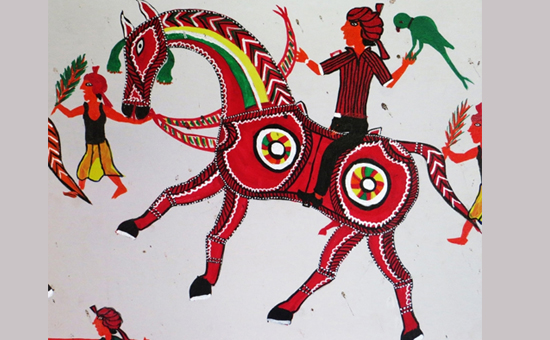 Baba Pithora.
Baba Pithora.
In Pithora
painting, he is portrayed as young, strong and manly with a parrot
and a flower is his hand. Baba Pithora for the Rathva is a conglomeration of
different gods, animals, nature, and all creations of the universe.
Pithori
Rani is the wife of Baba Pithora and daughter of Abho Kunbi.
 Pithora Rani.
Pithora Rani.
In
the Pithora painting, she carries a fan in her hand. She is worshipped during
times of erratic monsoons. In the painting, she is portrayed as celestial and a
devoted wife ready to aid her husband in all his endeavors.
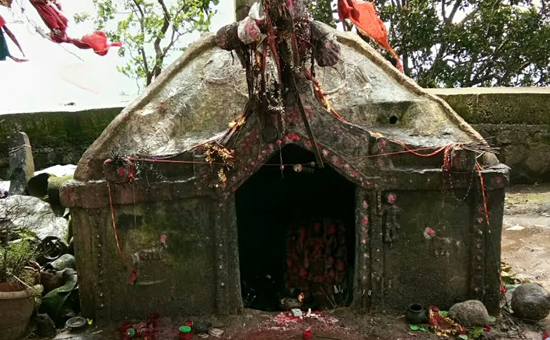 Temple of Rani Kajal.
Temple of Rani Kajal.
Rani
Kajal is the sister of Baba Ind and foster mother of Baba Pithora.
She rescued Pithora as a child from the sea and looked after him. In the
Pithora painting, she is painted on the left side and has a very important
status as a mother.
She
is also worshipped as Kuldevi or
the goddess of the clan. She carries a comb in her hand, which symbolizes her
ability to cleanse the world. The temple of Rani Kajal is on a mountain near
Mathvad village near river Narmada along the borders of Gujarat and Madhya
Pradesh.
Baar Matha no
Dhani
(The Enlightened One with 12 Heads) protects the Adivasi from all 12
directions. He possesses knowledge of the universe, and protects living
organisms and nature, and is a very brave deity.
In
Pithora painting, he is portrayed holding Nagdevta (Lord of Snakes) in his hands along with swords. Baar
Matha no Dhani offered protection to Rani Kali Koyal, when she was in labour,
which is why he is an essential and recurring character in most of the Pithora
paintings. Several scholars compare this Rathva deity with
Ravana from Ramayana, but the Rathva claim that they are not the
same and are decisively different.
Raja
Bhoj and his elephant: Raja Bhoj was a great, rich and generous king
who was very benevolent to his subjects. He would organize a grand celebration
of the Dussehra festival, and would himself join the procession on
his elephant.
In
the Pithora painting, he is always portrayed riding an elephant with a huge
Ambadi or an umbrella. Raja Bhoj looks after agriculture, livestock
and rain on earth, which is why he is also known as Raja Bavaji.
 Raja Bhoj.
Raja Bhoj.
Abho
Kunbi and Mathari (the farming couple) are creators of the art of
farming. They are also credited with teaching this art to the human race. They
taught them how to sow seeds, prepare fields for sowing, till farms,
harvesting, and all associated activities related to farming and agriculture.
Pithori Rani, the wife of Baba Pithora is the daughter of Abho Kunbi and
Mathari.
Nakti Bhuten is portrayed
on a white horse, placed on the left of the Pithora painting. He is
protector of the household and is very different from other gods and goddesses.
His appearance is very fierce and he is a very powerful deity.
Lakhari and Jokhari (authors of future) according to the traditional beliefs, on the fifth or sixth day after a child's birth, Lakhari and Jokhari visit their homes to write their future. It is said whatever predictions are made on this occasion never fail to materialize.
In
the story of Baba Pithora, Lakhari and Jokhari wrote about his future on the
wall, the chosen seat of Baba Pithora. It is since then the tradition of
painting Pithora on the wall has begun, and Lakhari and Jokhari are portrayed
in the painting.
Purvaj na Panch
Ghoda
(five horses of ancestors) in memory of their ancestors, the
Rathva places intricately carved wooden horses either in the farms or in
their homes. They recognize these artifacts as Khatrij Dev. The Khatrij Dev is the first deity to be worshipped on
all important occasions and festivals. Every year, each family organizes a
village feast in memory of their ancestors. In the Pithora painting,
Purvaj na Panch Ghoda are a symbolic representation of the ancestors of the
community.

Photo credits here
Motifs of Nature
The
sky, gods, earth, human beings, vegetation, animals, birds and all living
creatures of the universe are comprehensively incorporated in the Pithora
painting of the Rathva community. They exhibit a prudent understanding of
the universe through the medium of their painting. The recurring motifs related
to elements of nature are the sun, moon, and trees that are considered holy by
the Rathva.
The
sun is a living god for all living beings of the universe. He is known as Huriyadev by the Rathva and is
considered the universal guardian. The moon is considered a god and is
also known as Handaryo Dev by the Rathva community. They also recognize
eclipses and signal these through their famous kikiyari howl.
The
branches of kadam tree are important in the ritual of the Pithora
painting. The family of Ghardhani takes out a procession to the nearest
kadam tree to gather its branches; the dhol and pehi are played in the
background.
The
Tad and Khajoori trees can be seen extensively in Adivasi areas. The tad tree
yields a sweet fruit called tadkali which
is used to make nira, which is a very
healthy and medicinal drink and is the main ingredient for making the alcohol
drink called tadi. The leaves of the tad tree were used for making roofs
and walls of Rathva homes and used as a medium to write on. Similarly, the
khajoori tree has many uses apart from its fruit khajoor (dates).

Rathva Painting credits here
Motifs related to animals
The
Adivasi have a vast tradition exemplifying their unique closeness to
nature, living in harmony with the animal kingdom. A wide range of animals are
portrayed in the Pithora painting of the Rathvas.
The
Saval Dharmi Ghoda (horses of civic
righteousness) are an important element of the Pithora painting. In the
cultural tradition of the Adivasi, there are several mentions of the great
exploits of heroes, and Saval Dharmi Ghoda represents these heroes in the
Pithora paintings.
The Rathvas consider the buffalo and cow holy animals. Their produce - milk, buttermilk, dung, curd etc. and are extremely important in the lives of the Rathva. Cow dung is also utilized in several ceremonies of the Baba Pithora ritual. The Rathva’s believe that the goat was the first animal to be domesticated by their ancestors. The working class of the Adivasi community often rear goats to meet their milking needs. The
goat is an important part of the Baba Pithora ritual, since it is a common
choice for animal sacrifice.
Lion
is the symbol of strength and religion; he is also the most powerful animal
and a vehicle of several gods. Tiger is portrayed as the protector in the
painting. Lion and tiger are portrayed atop the celestial gate, as they
protect the inhabitants. The Rathva, Nayak and Tadvi communities celebrate
a ritual to entice the rain, when people in the costume of camels go out
in procession. This ritual is called untadi
kadvi ('bring out the camel').
Deer
is considered a symbol of beauty, naivete, honesty and a lover of music by the
Rathva. In Pithora paintings, sometime a two-headed deer is also
portrayed. Chicken is another common choice for animal sacrifice. The peacock
features in the Pithora paintings as a vehicle of the goddess.
The
Koyal bird features in the Pithora painting as symbolic representation of Rani
Kali Koyal, the birth mother of Baba Pithora and the most beautiful sister
of Baba Ind.
Mamo
Karodiyo is considered the maternal uncle of Baba Pithora. Once upon a
time, when Baba Pithora was on a quest to meet Baba Ind and needed to
climb to heaven, he sought the aid of Mama Karodiyo who helped him
climb up to heaven on his web. This is how Mamo Karodiyo found his way
into Pithora painting.
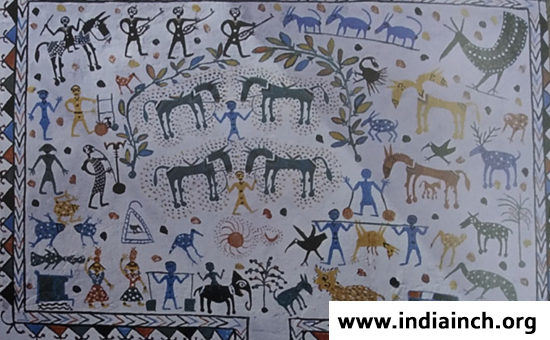
Reference
and photo credits here
Motifs related to human activities
Pithora
painting shows several human characters and scenes of daily activities: the
Bhuva conducting ceremonies, the village tradesman, the hunter, policeman,
village postman, alcohol making, buttermilk churning, women drawing water
from wells or hand pumps, men and women dancing.
Ashad has
two interpretations in the Pithora painting of the Rathva. The first states
that it is a canopy for the procession of gods and goddesses while the
other interprets it as a symbolic border of a village.
Pithora
painting also depicts instruments of daily life.
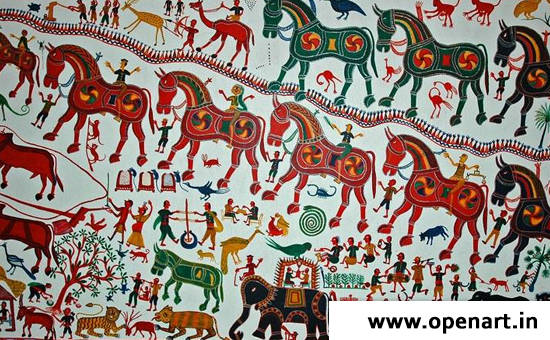
Reference and Photo credit
here
How the paintings are made
The process begins with lipai (preparing the canvas) which traditionally comprises setting the background of walls with dung, water and chuna (limestone). Painted in spectacular and vivid reds, greens, oranges, blues and pinks- birds, animals, trees and the cosmos – all find their representation through these paintings.
It
is considered sacred to paint horses, the sun, and the moon which, are believed
to be the three lucky mascots in Bhilala mythological stories, characterising
and distinguishing these paintings.
Daily
activities of rural life such as farming, hunting, ploughing, and exuberance in
festivities like dancing and singing in revelry, depicting social cohesion are
exhibited through colours and imagination with highest reverence
to Pithora Dev (deity) and local gods.
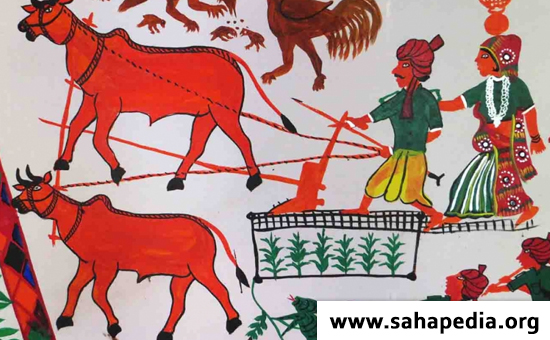
Reference and photo credit here
Choosing the subjects
An
important feature of authentic Pithora art is that no two paintings are ever
similar.
The backgrounds are white or crème in colour but could be stark red for a rustic mud colour appeal suiting contemporary tastes. Tribal chores are depicted beautifully on these paintings which have over time become quite a home decor product finding distant refuge in urban homes.
The
authentic portrayal of the village and tribal life is done ecstatically to
present hardship and occasional festivity, thus representing the co-existence
of hope and despair in tribal lives, through the depiction of daily chores and
celebrations at the same time, making a painting complete.
The
best artworks are only created on a mud wall or floor, they have also started
painting on bags, walls, bedsheets, table-clothes and even costumes. It is
important to expand the canvas in order to sustain.
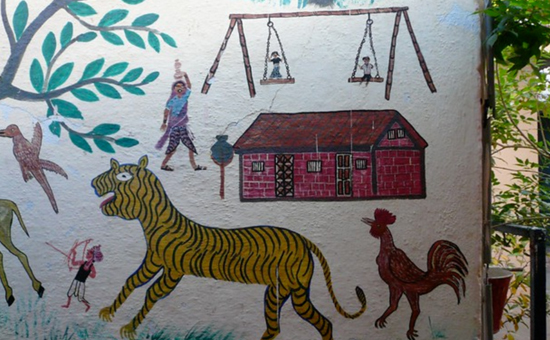
Photo credit here
Conclusion
A
Pithora painting can have up to 165 different types of motif depicted.
Each motif is associated with an extensive literature signifying its importance
within the painting. Each character is presented as a protagonist in an
important event of the vast mythological epic of Baba Pithora. The motifs
reveal the manner in which the Adivasi view their world. They represent
the significance of elements of nature, flora, fauna and celestial
elements, and their influence on their very lives.
The
purpose of this compilation is to document and promote. We have given credits
and reference links in this compilation. In case some are missed, it is not
with malafide intent.
To read all
articles by author
To read all articles
on Indian Art